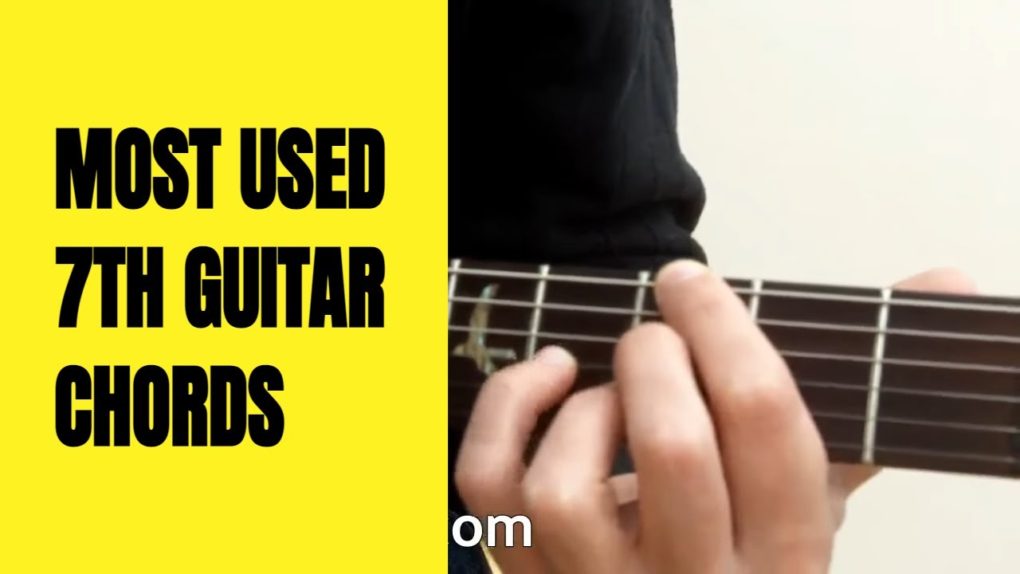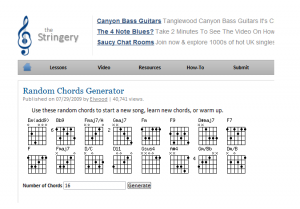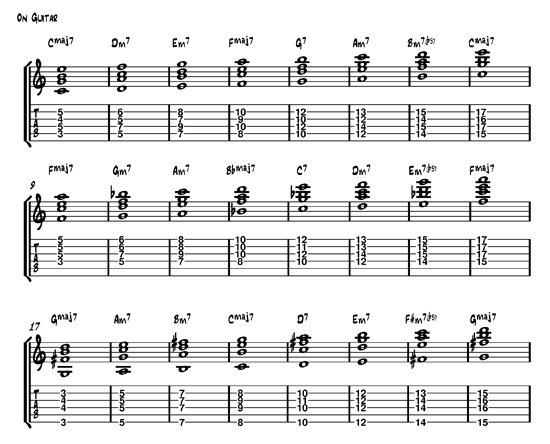Tag: theory

Most used 7th guitar chord shapes
In this video I show the most common 7th chord shapes, it’s all pretty self explanatory! for the theory you can also checkout these other lessons:
https://www.giannichiarello.com/understanding-how-triads-and-other-chords-are-built
https://www.giannichiarello.com/from-the-major-scale-to-the-harmonized-scale-pt-2-7th-chords
And the shapes I use are here:
hhttps://www.giannichiarello.com/LESSON%20MATERIAL/7th%20chords.jpg
Harmonized major scale with 7th chords on guitar
Factorial Thinking (Combinations applied to music)
Today’s’ tip has to do with mathematics applied to music…we have already seen how in the finger combinations exercises we have used all the possible combinations of 2,3 and 4 fingers of our left hand to make sure we cover every possible motion. This is not only a great warm up and technical exercise, but also a way to keep your brain connected.
Let’s see how we can now apply this to notes, chords, arpeggios, and so on. These are the combinations we have see in the previous post:
Finger combinations (combinations of all numbers from 1 to 4 as left hand fingers are numbered that way on guitar)
12 13 14
21 23 24
31 32 34
41 42 43
123 124 132 134 142 143
213 214 231 234 241 243
312 314 321 324 341 342
412 413 421 423 431 432
1234 1243 1324 1342 1423 1432
2134 2143 2314 2341 2413 2431
3124 3142 3214 3241 2413 2431
4123 4132 4213 4231 4312 4321
Let’s apply this to a 7th arpeggio: I will replace all the 2 with 3s, the 3 with 5s and the 4 with 7s.
Combinations applied to Chord Tones
13 15 17
31 35 37
51 53 57
71 73 75
135 137 153 157 173 175
315 317 351 357 371 375
513 517 531 537 571 573
713 715 731 735 751 753
1357 1375 1537 1573 1735 1753
3157 3175 3517 3571 3715 3751
5137 5173 5317 5371 3715 3751
7135 7153 7315 7351 7513 7531
Let’s make an example in the key of C: this is Cmaj7 every possible combination of the four notes.
Combinations applied to Chord Tones of Cmaj7
CE CG CB
EC EG EB
GC GE GB
BC BE BG
CEG CEB CGE CGB CBE CBG
ECG ECB EGC EGB EBC EBG
3GCE GCB GEC GEB GBC GBE
BCE BCG BEC BEG BGC BGE
CEGB CEBG CGEB CGBE CBEG CBGE
ECGB ECBG EGCB EGBC EBCG EBGC
GCEB GCBE GECB GEBC EBCG EBGC
BCEG BCGE BECG BEGC BGCE BGEC
Obviously this is not music as such, but I always find that incorporating things like these in your daily practice routine can lead you to discover new material, or just find faults to fix in your playing. As an example go through the combinations and find a combination you like and that sounds more musical to you…play in all 12 keys, apply it to a tune like ‘Autumn leaves’ taking it around the changes and modifying it to match the chord of the moment.
Good luck!
A tool to improve your improvising skills.
It’s not a secret that one of my all time favourite guitar instructional books is The Advancing Guitarist by Mick Goodrich. One the exercises explained in this great book is about creating a random sequence of chords by writing every type of chord (major, minor, all the 7th chords and, if you feel more adventurous, chords with extensions and alterations) on small pieces of paper and extracting them at random. This will not only improve your sight reading in terms of chords and chord progressions, but, if you record these sequences to create a backing track, it will greatly improve your improvisation skills.
This is where http://www.thestringery.com/featured/random-chords-generator/ comes into play.

On this site you can easily generate random sequences to improve your chord recognition knowledge and improvisational skill. The default number of chords is 16 but you can easily change that number. I advice to play along to a drum beat or a metronome, so that you are more focused, starting with a chord per bar.
Also you could leave the recording backing track for a few days, so you completely forget what you recorded, and use it to practice your aural recognition skills (ear training). Try and see if you can recognise a major chord from a minor, or what extensions are contained in a chord.
I am also sure you will find some ‘snippets’ that will inspire you…maybe the beginning of your next masterpiece.
